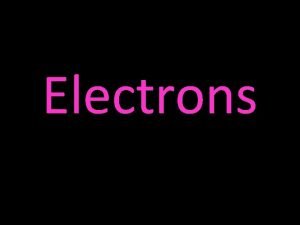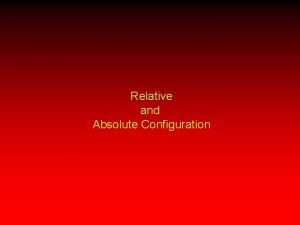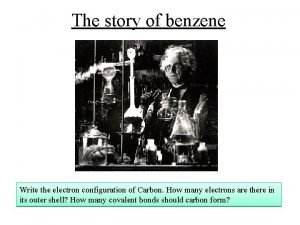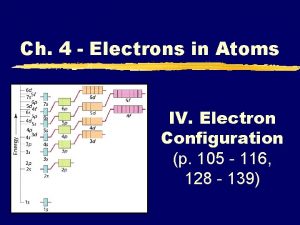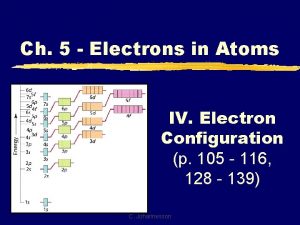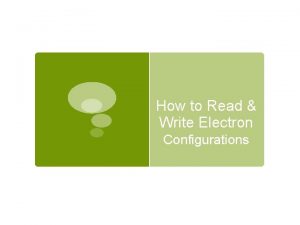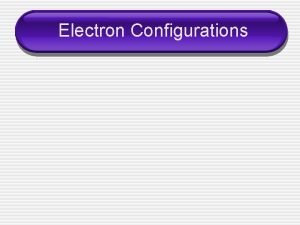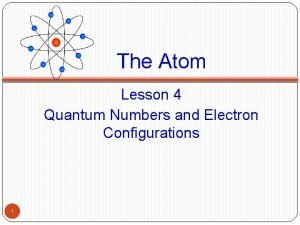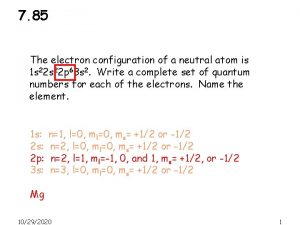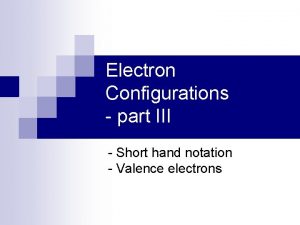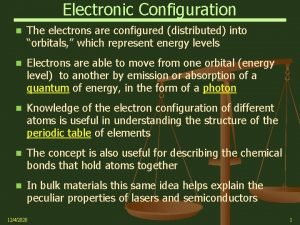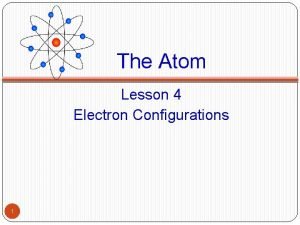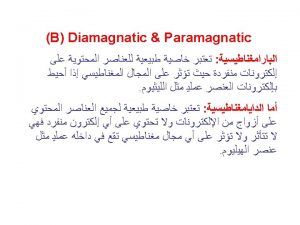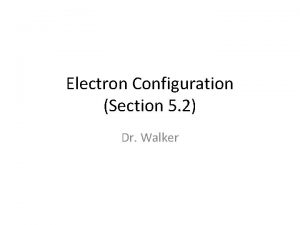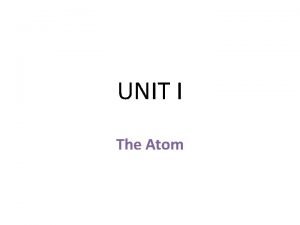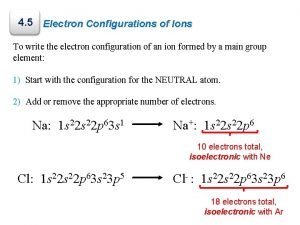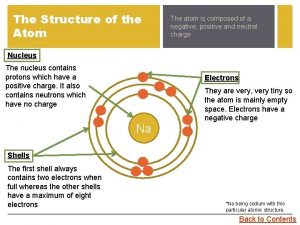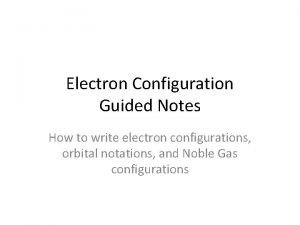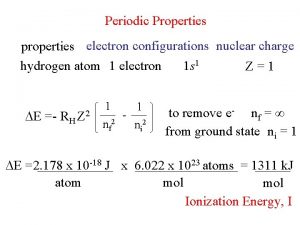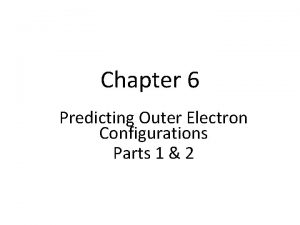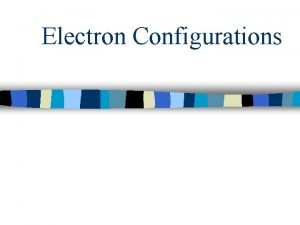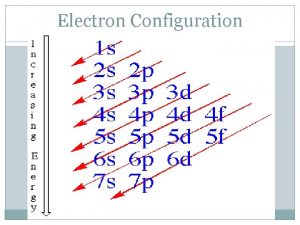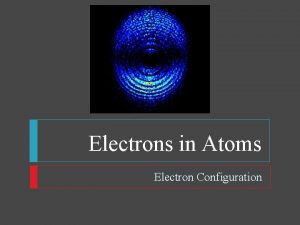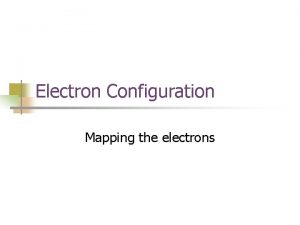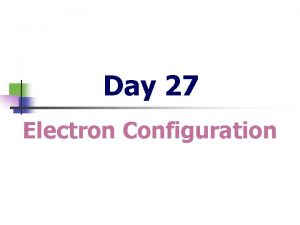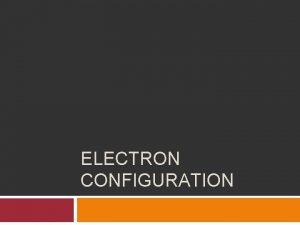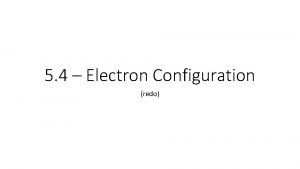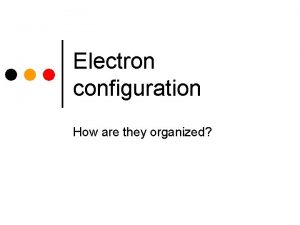Electron Configuration H Chemistry Mrs Cool Electron Configuration





























- Slides: 29

Electron Configuration H. Chemistry Mrs. Cool

Electron Configuration The way electrons are arranged around the nucleus. n an “electron address” n

Quantum Mechanical Model n n 1920’s Werner Heisenberg (Uncertainty Principle) Louis de Broglie (electron has wave properties) Erwin Schrodinger (mathematical equations using probability, quantum numbers)

Principal Quantum Number, n n Indicates main energy levels (distance from the nucleus) n = 1, 2, 3, 4… n Each main energy level has sub-shells depending on its energy n s p d f g

n The principle quantum number, n, determines the number of subshells within the principle energy level.

Angular Quantum Number, ℓ (Angular Momentum Quantum Number) n n Indicates shape of orbital subshells ℓ = n-1 ℓ sublevel____shape___ 0 1 2 3 4 s p d f g sphere “propeller” cloverleaf “flower”

Orbital n n The space where there is a high probability that it is occupied by a pair of electrons. Orbitals are solutions of Schrodinger’s equations.

Orbitals in Subshells Subshell s p d f g # Orbitals 1 3 5 7 9 # electrons 2 6 10 14 18

Magnetic Quantum Number mℓ n n This tells you how the orbital is oriented in space. Its values are - ℓ … 0…+ ℓ n n n Since the s orbital (a sphere) can have only 1 orientation, the only value for its mℓ =0 A p orbital can fall on the x, y, or z axis, so it has 3 values for mℓ : -1, 0, 1 There are 5 possiblities for the d orbitals orientation, so there are 5 mℓ values.

Magnetic Spin Quantum Number ms n n n Since each orbital can hold 2 electrons, there must be a way to distinguish between the two. We do this by saying one spins “clockwise” and one spins “counter-clockwise”. The numeric designations are +½ and -½

Quantum Numbers & Electron Configuration n n In all, 4 quantum numbers are needed to describe the probable location of any electron in an atom. Sometimes quantum numbers aren’t the most convenient way to picture electrons in an atom, so we also use a more “visual” way…

Three rules are used to build the electron configuration: Aufbau principle n Pauli Exclusion Principle n Hund’s Rule n

Aufbau Principle Electrons occupy orbitals of lower energy first. n This means that the first 2 electrons of any atom will always be (most probably) in the 1 s orbital. n

Aufbau Diagram

The diagonal rule

Hund’s Rule In a set of orbitals, the electrons will fill the orbitals in a way that would give the maximum number of parallel spins (maximum number of unpaired electrons). Analogy: Students could fill each seat of a school bus, one person at a time, before doubling up.

-Pauli Exclusion Principle (Wolfgang Pauli, Austria, 1900 -1958) -Electron Spin Quantum Number n n An orbital can hold only two electrons and they must have opposite spin. Electron Spin Quantum Number (ms): +1/2, -1/2

Aufbau Diagram for Hydrogen

Aufbau Diagram for Helium

Aufbau Diagram for Lithium

Aufbau Diagram for Beryllium

Aufbau Diagram for Boron

Aufbau Diagram for Carbon

Aufbau Diagram for Nitrogen

Aufbau Diagram for Fluorine

Standard Notation of Fluorine 2 1 s y g r e n E n i Ma el v s r e e L b m Nu , 2 2 , 1 Number of electrons in the sub level 2, 2, 5 2 2 s 5 2 p Sublevels

Shorthand Notation n n Use the last noble gas that is located in the periodic table right before the element. Write the symbol of the noble gas in brackets. Write the remaining configuration after the brackets. Ex: Fluorine: [He] 2 s 2 2 p 5

Blocks in the Periodic Table

Exceptions (of course) They prove the rules n n Sometimes an element doesn’t exactly follow the Aufbau rule, because it is more stable with a different e- config. Two important exceptions: n n n Chromium- Expected [Ar] 4 s 2 3 d 4 Actual [Ar] 4 s 1 3 d 5 Copper- Expected [Ar] 4 s 2 3 d 4 Actual [Ar] 4 s 1 3 d 5 Having a half-full or full subshell is a more stable condition.
 Electron configuration vs noble gas configuration
Electron configuration vs noble gas configuration Electronic configuration
Electronic configuration They are mrs garcia and mrs castro
They are mrs garcia and mrs castro Mrs. darling was ___________ of mrs. s.
Mrs. darling was ___________ of mrs. s. They are mrs garcia and mrs castro
They are mrs garcia and mrs castro Chrhh
Chrhh What is absolute configuration
What is absolute configuration Spiranes structure
Spiranes structure Sn 4+ electron configuration
Sn 4+ electron configuration Electron configuration boarding house
Electron configuration boarding house Electron configuration of benzene
Electron configuration of benzene Stability and electron configuration ch 4
Stability and electron configuration ch 4 Electron configuration for oxygen
Electron configuration for oxygen Write the electron configuration for a neutral atom of tin.
Write the electron configuration for a neutral atom of tin. Electron configuration arrow diagram
Electron configuration arrow diagram Quantum numbers and electron configuration
Quantum numbers and electron configuration átomo
átomo Which neutral atom is isoelectronic with o+
Which neutral atom is isoelectronic with o+ Shorthand electron configuration for arsenic
Shorthand electron configuration for arsenic N and l electron configuration
N and l electron configuration Electronic configuration
Electronic configuration Electrons
Electrons Shorthand electron configuration for potassium
Shorthand electron configuration for potassium Au-197=50 au 198=50
Au-197=50 au 198=50 Ionic 5 electron
Ionic 5 electron Electron configuration of ci 17
Electron configuration of ci 17 Orbital sublevels
Orbital sublevels Nuclear charge
Nuclear charge 82pb electron configuration
82pb electron configuration What does electron configuration notation eliminate?
What does electron configuration notation eliminate?

